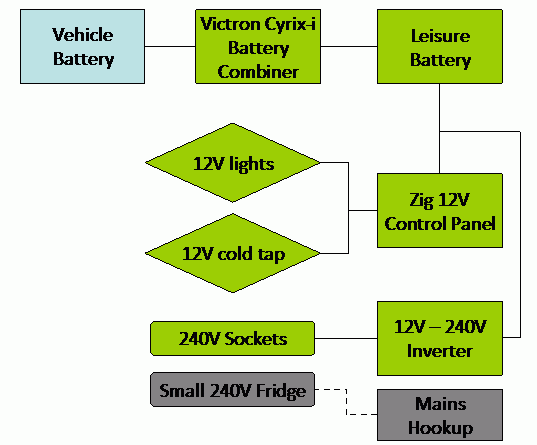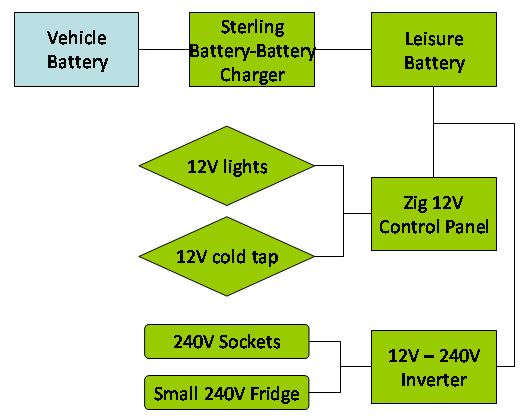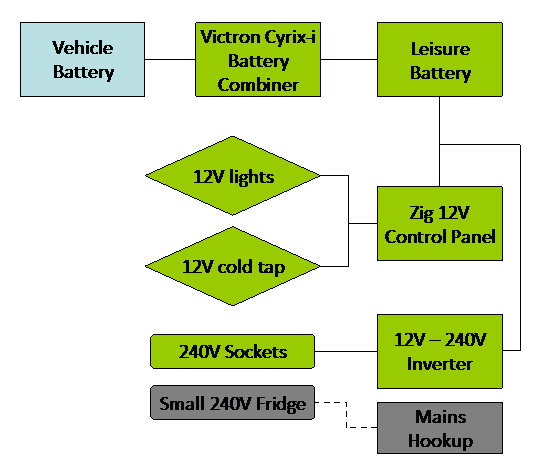
Electrics & Fridge (Updated 12/11/10)
Disclosure: Links marked with (eBay⇒) or (Amazon⇒) are affiliate links. This means I get paid a small commission if you buy something after clicking on the links. This money helps to pay for the running of the website.
With the spectre of liability looming over my head, I’m afraid I am not going to publish very much on the subject of electrics. Wiring in mains and 12V electrics and connecting them up to your vehicle’s electrics does require a little care and a degree of electrical knowledge and understanding.
That said, I have put together a high-level diagram of the system I used in my conversion, in the hope that this might provide some ideas for a slightly basic, but very self-sufficient setup.
Our electrical requirements were quite limited:
Power a small fridgeOr not – see below- Electric lights (eBay⇒) (LEDs for lower power consumption)
- Charge the leisure battery (eBay⇒) properly while driving, removing need for hookup
- Power mobile phone/camera chargers
- Water pump (eBay⇒) and cold tap (eBay⇒)
Mk1 Electrics – Not Reliable (Scroll down for Mk2 Solution!)
You’ll have to forgive the poor quality of the graphics – I couldn’t make PowerPoint save nicely and the colours are rather dodgy… still, I hope the meaning is clear. Note that details like fusing and earthing are missing:

Most of this solution is simple and conventional and works well to this day. The unusual bit is using an inverter to power a small 240V fridge (like a hotel mini bar fridge). I gambled that by using a Sterling Power Battery-Battery Charger (eBay⇒) I could keep the 110Ah leisure battery sufficiently charged to make this work. Despite the remarkable performance of this charger, in the end, I was wrong.
The fridge/inverter combination required too much power and the massive current surge every time the compressor started fried one inverter and blew the fuses on a second inverter. In addition, having the inverter permanently switched on drained the battery too fast – larger inverters have a significant quiescent (idle) current that will eat away at the charge of your leisure battery (0.4A in my case, equating to 9.6Ah per day without doing anything).
This design might have worked if I had two or three times as much battery capacity, but I’m still not convinced. I think you would be better off spending the money on a proper motorhome fridge than a huge battery bank.
Lesson Learned: I have now concluded that the only fridge setups that make sense and allow some independence from mains hookup are a three-way (gas & electric) fridge or a 12V compressor fridge, which is more power efficient – hence the £400+ price tags they carry.
Mk2 Electrics – Good reliable solution but no fridge
Having been too clever for our own good with our inverter/240V fridge setup, we decided to remove the fridge from the system and see how things went. Predictably, we had no problems at all and leisure battery life suddenly became more than ample.
The Sterling Battery to Battery Charger now seemed like overkill – and we discovered that as its list price had risen considerably since we purchased ours, we were able to sell our second-hand unit at a small profit on eBay! So we did.
We replaced the B2B charger with a Victron Cyrix-i Battery Combiner (eBay⇒) – basically a clever, voltage sensing relay that does not need an alternator or ignition connection. It just installs between the starter and leisure batteries in the same way that the B2B Charger did. Here’s a diagram of our current electrical setup. Note that as before details such as fusing and earthing have been omitted:
 As our 240V fridge was built into the side conversion, removing it and replacing it with a different unit would involve dismantling and altering some of the cupboards. We have decided not to do this and so now do not have a fridge except when we have mains hookup (rarely). We use the fridge as a cool cupboard and for most things, this works quite well – somehow the fridge stays noticeably cool inside unless the weather is quite warm. Obviously not good enough for fresh meat, but ok for most other things, within reason.
As our 240V fridge was built into the side conversion, removing it and replacing it with a different unit would involve dismantling and altering some of the cupboards. We have decided not to do this and so now do not have a fridge except when we have mains hookup (rarely). We use the fridge as a cool cupboard and for most things, this works quite well – somehow the fridge stays noticeably cool inside unless the weather is quite warm. Obviously not good enough for fresh meat, but ok for most other things, within reason.
We have found that we can manage quite well without a fridge, although it would be nice to have one sometimes. Ironically, if we had stuck to the cheapest solution of all, a 12V coolbox, we would be better off. We could run it from the cigarette lighter during the day, switch it off at night, and have most of the benefits of a real fridge.
The rest of the electrical setup works very well and our single 110Ah battery gives more than enough power to support our LED lights (eBay⇒), water pump (eBay⇒) and charging laptops and mobiles through the inverter (eBay⇒).
Next: Water & Plumbing
Back to the Conversion Guide Index
Disclaimer: All material is provided for information purposes and is my opinion only. I can take no responsibility for the accuracy, suitability, reliability or safety of the information in this guide.


Hi Roland,
More great info here, I was going for a simple relay system but will defo go for a battery to battery charger. 1 little question. I will have a similar load to you (in electrical terms) except I might have a computer working too. Did you get the 10amp (output) charger 50amp or 100amp? I am thinking 50 is plenty but don’t want to save £100 if in the long run I will need more power.
Also I am struggling to understand the difference between a battery to battery charger and an alternator to battery charger and which one I need?
Thanks again for your help. I have my van (vivaro hi-top) and am starting insulation this week! weehee
Hi Benny,
Thanks for your comment. I do think the battery-to-battery charger is a good piece of equipment but I have to admit that I have swapped mine for a relay as once I stopped powering the fridge from the battery, I didn’t need such an intensive charging solution (see my comments in the “240V Fridge & Inverter Update” section of this page).
I had the 50A charger, which I suspect was as much as my alternator could handle, in any case. It might be worth trying to find out the rating of your van’s alternator, just to make sure it will be able to handle providing so much power. I think these chargers are primarily designed for vehicles and boats with bigger engines/alternators.
The battery-to-battery charger connects to your van’s starter battery and to your leisure battery. This made wiring easy in my Transit because the starter battery is under the driver’s seat. Not sure about the Vivaro. An alternator-battery charger connects to the van’s alternator and to the leisure battery. This may be slightly harder to wire up but is more conventional. I’m not sure if there is any difference in performance – if you phone Sterling they may be able to advise.
Finally – good luck with your conversion, I’d love to see a photo of the finished result! Insulation is well worth the effort – it was one of the simplest and most effective things I did with my van.
Roland
Hi again Roland,
things are coming along. I am fully insulated and on the windows at the moment.
Did you ever run a laptop of your electrics? I am looking into modified and pure sine wave inverters at the moment, and there is a lot of disagreement online about whether a laptop needs a pure sine wave inverter or not. My mate who is an electrician say it doesn’t but lots of web sites say that a laptop is very sensitive and does, they might just be trying to make more cash though, wondered if you had any first hand experience of this?
cheers Benny
Hi Benny,
Glad things are going well with your conversion. I have only ever used modified sine wave inverters but do take some precautions.
I use a laptop in the van but tend to run it from the battery and only use an inverter to charge it (with the laptop switched off). I’ve done this with several laptops over the years and they all seem to charge normally in this way.
I have occasionally used laptops powered directly from the inverter and the results have been mixed. With one laptop, it worked fine. On another laptop, the trackpad stopped working and only started again once it had been restarted on battery power.
I also charge mobile phones (switched on) from the inverter without problems.
I think that both sides of the argument have some truth – not everything works perfectly with a modified sine wave inverter, but these days, most things do.
All of the above is based solely on my own personal experience but it is consistent with most of what I’ve heard from other people.
One alternative to an inverter is to buy 12V power supplies for your main appliances – typically mobile and laptop. These are available quite cheaply and allow you to power your devices directly from a 12V supply, without converting it to mains. This is far more efficient as electronic devices like laptops all use low voltage DC power supplies anyway, so this approach avoids a double conversion (DC->AC->DC).
If you do take this approach, however, you need to make sure that the power supply you use operates at the correct voltage for your device and can provide enough current – this information will probably be printed on your laptop’s power supply.
Cheers,
Roland
I use a large American style cool box
I fill the bottom with ice and a couple of litres of water
This combination I find keeps milk and other bottles especially beers nice and cold.
A rack on top keeps dairy product cool enough for a couple of days.
Topping up with ice in equal amounts and extracting equal amount of water works.
Don’t know where to start, do I need to do electrics before anything else on my conversion
Hi Lee,
If you want the wiring to be hidden behind the panels on the roof/walls, then this probably needs to be put in place before you start building the furniture. What I did was to put all the wires in place (without connecting them up) so that they were sticking out of the roof/walls in the right place for when I wanted to fit my lights, etc, later on.
Getting started can be difficult. The best plan, in my view, is to try and write down a job list that will take you from start to finish. Ask yourself if each stage is possible without having to undo any of the previous jobs!
Hope this helps…
Roland
One advantage of a battery to battery charger over a relay is if the leisure battery is discharged.
The b2b should limit the current whilst a relay will simply act as a switch and the high current flow could, at best, blow a fuse and at worst burn out the wiring or cause a fire.
Interesting series of articles, learning LOTS!
Thanks